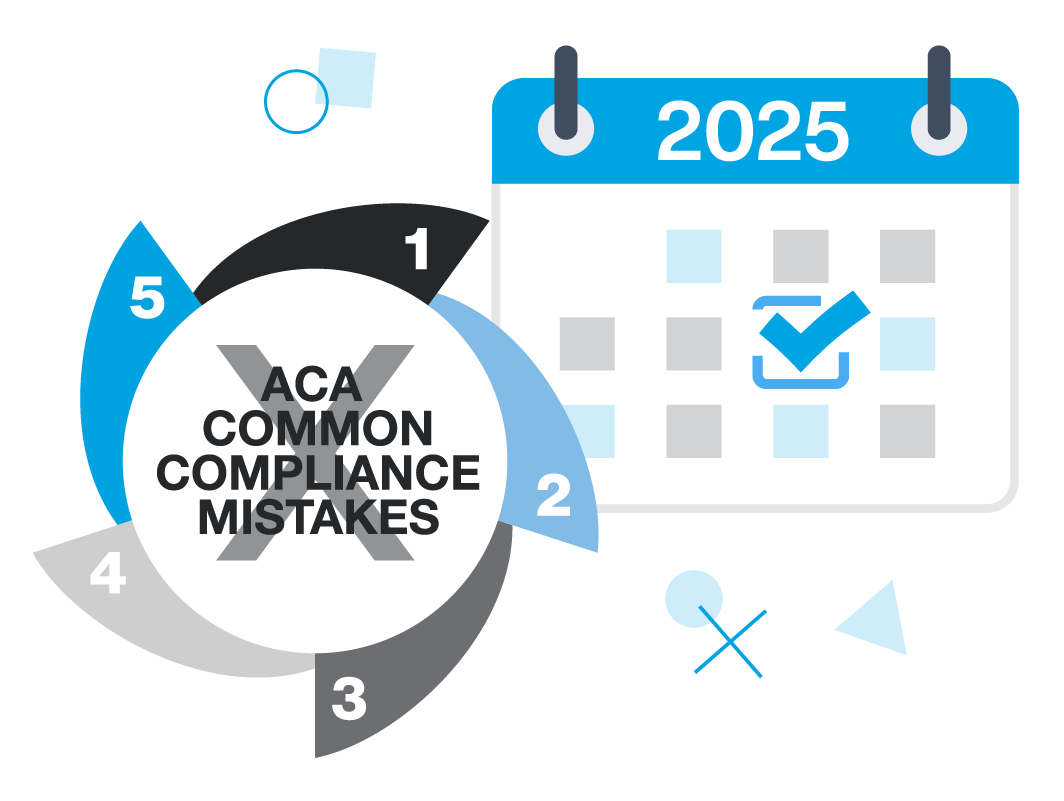With open enrollment for the 2025 calendar year beginning Nov. 1, organizations should turn their attention to ACA compliance efforts to ensure their processes and procedures for administering health plans are buttoned-up.
Even though we’re now heading into the 10th year of ACA reporting, organizations still make ACA compliance mistakes when it comes to the requirements of the ACA’s Employer Mandate.
The ACA’s Employer Mandate requires employers with 50 or more full-time or full-time-equivalent employees to provide Minimum Essential Coverage (MEC) that also meets Minimum Value (MV) to at least 95% of their full-time workforce and their dependents.
Navigating the intricacies of the ACA’s Employer Mandate can be challenging for businesses of all sizes and making ACA compliance mistakes can lead to significant financial penalties from the IRS, such as Letter 226J.
Organizations should remain cognizant of common ACA compliance hiccups and deploy strategies for avoiding them.
Mistake 1: Misclassification of Employees
One of the most critical ACA compliance mistakes organizations can make is misclassifying employees. That’s because worker classifications, such as full-time, part-time, or seasonal, directly impact an employee’s eligibility for ACA coverage.
The most common reason organizations misclassify their workers is due to inadequate training, poor documentation, bad data input, and a lack of understanding. When employees have incorrect classifications, they may not receive an offer of coverage, and subsequently could obtain a Premium Tax Credit from a state or federal healthcare exchange. This change of events prompt the IRS to issues a penalty notice to the organization for failing to provide sufficient ACA coverage.
It’s clear then that employee classification errors can be costly for organizations. To avoid this ACA compliance mistake, educate your HR teams on ACA regulations, which state that ACA full-time is anyone who averages 30 hours of service a week or 130 a month. Also ensure you’re consistently using the same criteria for classifying employees.
Best practices suggest teaming up with an expert in ACA compliance, so that you can work together to create a system for differentiating employee classifications. Doing so will help create a foundation for documenting employee types and benefits eligibility.
Mistake 2: Incorrect Measurement Method Application
The IRS sanctions two measurement methods for determining employee eligibility for ACA coverage: the Look-Back Measurement Method and the Monthly Measurement Method. These methods have vastly different processes for calculating ACA full-time status.
The Look-Back Measurement Method is better suited for organizations with high variable-hour workforces, like those in the restaurants, construction, hospitality and education industries. The Monthly Measurement Method is a simpler system that aligns more with workforces that have predominantly full-time, non-fluctuating hour employees.
Webinar: Crucial ACA Compliance Strategies for the Upcoming Filing Season
Choosing the wrong method, or implementing a measurement incorrectly can lead to coverage gaps and non-compliance.
To mitigate this risk, first consider your workforce type. Do you employ workers who have fluctuating schedules or do they have the same schedules each week? Next, verify your time and attendance tracking systems are working correctly and ensure your HR department is maintaining accurate records of shifts worked.
With this information you can determine which method will work best and subsequently implement the applicable measurement, administration, and stability periods.
Mistake 3: Poor Documentation of Health Plans
Choosing a health plan that adheres to the requirements of the ACA is one thing, documenting plan details is another. And failing to prove that the plans you offer are in fact compliant with Employer Mandate requirements is a mistake we see all too often.
Insufficient or inaccurate records of plan details and offerings can lead to compliance issues in the event of an IRS audit or inquiry.
To avoid this mistake make sure there is documentation to support the quality of your plans, including its cost, the eligible recipients, duration of availability, and the individuals who chose to enroll. Additionally, include details about any unique plan features like flex credits, opt-out payments, and health reimbursement arrangements.
Best practices encourage storing this information electronically so that it can be retrieved and circulated with greater ease.
Mistake 4: Inaccurate ACA Reporting
Accurate reporting of the annual 1094-C and 1095-C forms is a cornerstone of ACA compliance. Errors in reporting can lead to audits and penalties. In fact, our research finds that inaccurate ACA reporting is a top factor for prompting the IRS to issue penalty assessments.
These errors include incorrect code combinations, inaccurate full-time calculations, missing information on the 1094-C transmittal, and inconsistent EIN company details.
To prevent this ACA compliance mistake, implement a robust reporting system, double-check all information, and meet each filing deadline on time. This means giving yourself ample time for generating the 1095-C forms each year. The best way to achieve this in a timely fashion is to implement a monthly ACA compliance process.
Mistake 5: Disregard Key ACA Updates
The ACA is not a static law; it’s constantly evolving. Ignoring updates and changes to ACA regulations is a grave mistake, but in all fairness, an understandable one. Changes occur often and sometimes without warning. Take for example the evolution of state ACA reporting requirements, which change annually and impose additional requirements for employers with operations in those regions.
Failing to recognize the additional requirements, and their annual reporting changes can significantly impact your ACA compliance status. Some states, such as California, impose penalties for failing to complete ACA state reporting.
The same is true for the federal ACA requirements, which also have annual changing requirements, such as the affordability thresholds.
Get Help With ACA Compliance
ACA compliance is not a set it and forget it task for your HR team, and it’s certainly not something to only pay attention to during each years’ reporting season. Taking this approach is a guaranteed way of earning yourself an ACA penalty from the IRS.
The best way to avoid these ACA compliance mistakes is to call upon experts who understand not only the requirements of the law, but the process for ensuring successful compliance going forward.
Trusaic has helped thousands of clients prevent over $1 billion in ACA penalty assessments and can most certainly help your organization. To learn more about Trusaic’s ACA compliance services, including reporting, furnishing, IRS corrections, penalty responses, and state filing, check out our ACA Complete® solution.
For more information about ACA compliance mistakes, including which industries are most susceptible to penalties, read The Challenge of ACA Compliance research report.





